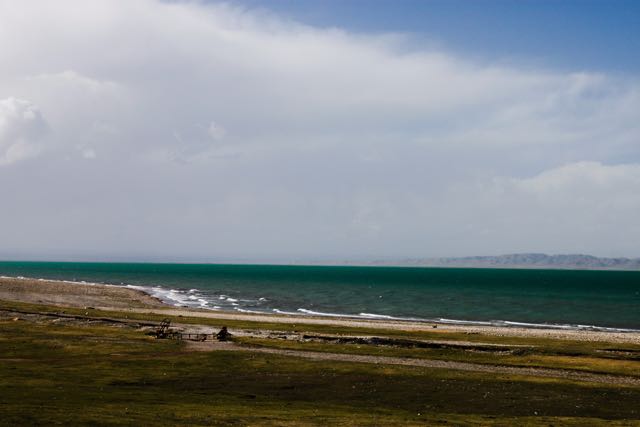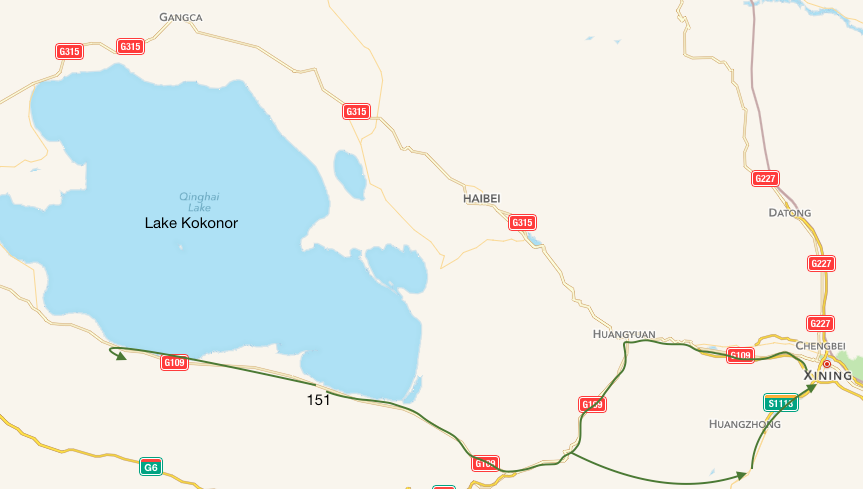Day trip to Qinghai lake (Kokonor).
 Lake Kokonor: (Mongolian : Хөх нуур)(Qinghai Lake) (Chinese: 青海湖), or Tsongon Po(Tibetan: མཚོ་སྔོན་པོ།) is the second largest lake in Asia. Located in Qinghai province on an endorheic basin, Kokonor Lake is classified as a saline andalkaline lake. It has a surface area of 4,317 square km; an average depth of 21m, and a maximum depth of 25.5m as measured in 2008.[2] The current Chinese name "Qinghai," the older Mongolian name Kokonor, and the Tibetan name "Trishor Gyalmo" (meaning 10,000 people were lost their lives as they submerged according to the local legend), respectively. The Lake is located about 160 kilometers west of the provincial capital of Xining (Tib: Ziling ཟི་ལིང་།) at 3,205 m (10,515 feet) above sea level in a depression of the Tibetan plateau.[3] Twenty-three rivers and streams empty into Qinghai Lake, most of them seasonal. Five permanent streams provide 80% of the total influx.[4] The lake has fluctuated in size, shrinking over much of the 20th century, but has increased since 2004. Despite its salinity, it has an abundance of fish, such as the edible naked carp (Gymnocypris przewalskii, huángyú .
Lake Kokonor: (Mongolian : Хөх нуур)(Qinghai Lake) (Chinese: 青海湖), or Tsongon Po(Tibetan: མཚོ་སྔོན་པོ།) is the second largest lake in Asia. Located in Qinghai province on an endorheic basin, Kokonor Lake is classified as a saline andalkaline lake. It has a surface area of 4,317 square km; an average depth of 21m, and a maximum depth of 25.5m as measured in 2008.[2] The current Chinese name "Qinghai," the older Mongolian name Kokonor, and the Tibetan name "Trishor Gyalmo" (meaning 10,000 people were lost their lives as they submerged according to the local legend), respectively. The Lake is located about 160 kilometers west of the provincial capital of Xining (Tib: Ziling ཟི་ལིང་།) at 3,205 m (10,515 feet) above sea level in a depression of the Tibetan plateau.[3] Twenty-three rivers and streams empty into Qinghai Lake, most of them seasonal. Five permanent streams provide 80% of the total influx.[4] The lake has fluctuated in size, shrinking over much of the 20th century, but has increased since 2004. Despite its salinity, it has an abundance of fish, such as the edible naked carp (Gymnocypris przewalskii, huángyú .
Geography
Qinghai Lake is sandwiched between Hainan and Haibei Tibetan Autonomous Prefectures in northeastern Qinghai. The lake is located at the crossroads of several bird migration routes across Asia. Many species use Qinghai as an intermediate stop during migration. At the tip of the peninsula on the western side of the lake are the "Bird Islands" (Cormorant Island and Egg Island), which have been bird sanctuaries of the Qinghai Lake Natural Protection Zone since 1997. The lake often remains frozen for three months continuously in winter. There is an island in the western part of the lake with a temple and a few hermitages called "Mahādeva, the Heart of the Lake" (mTsho snying Ma hā de wa) which historically was home to a Buddhist monastery.No boat was used during summer, so monks and pilgrims traveled to and fro only when the lake froze over in winter. A nomad described the size of the island by saying that: "if in the morning a she-goat starts to browse the grass around it clockwise and its kid anti-clockwise, they will meet only in the night, which shows how big the island is. It is also known as the place where Gushri Khan and other Khoshut Mongols migrated to during the 1620s. The lake is circumambulated by pilgrims, mainly Tibetan Buddhists, especially every Horse Year of the 12-year cycle. Przhevalsky estimated it would take about 8 days by horse or 15 walking to circumambulate the lake, but pilgrims report it takes about 18 days on horseback, and one took 23 days walking to complete the circuit

 .
.